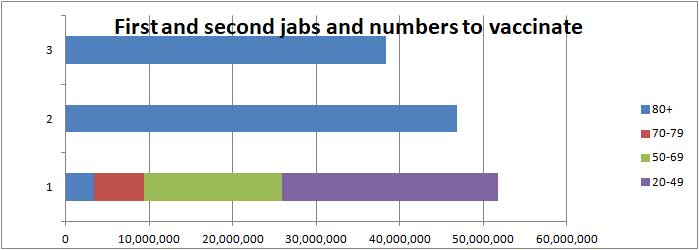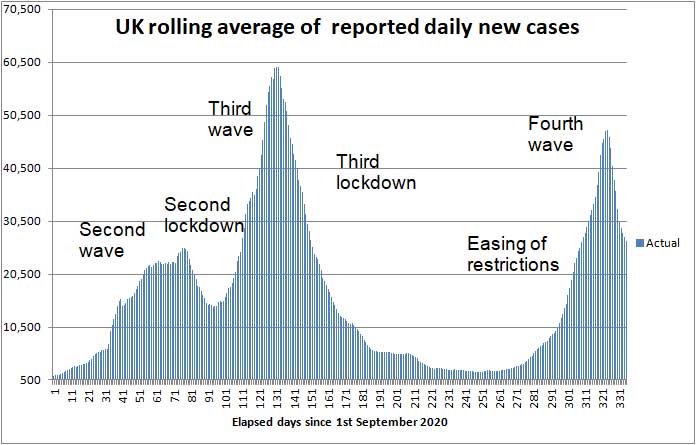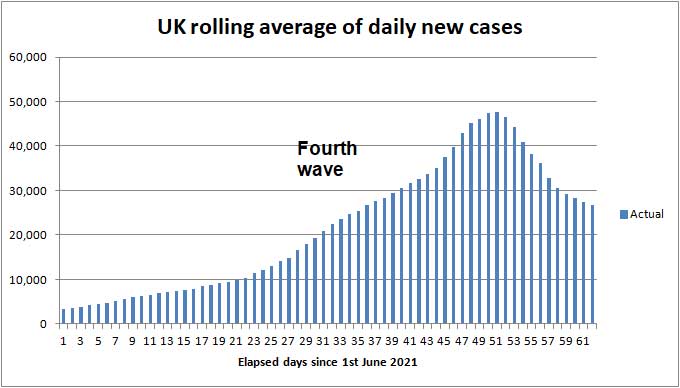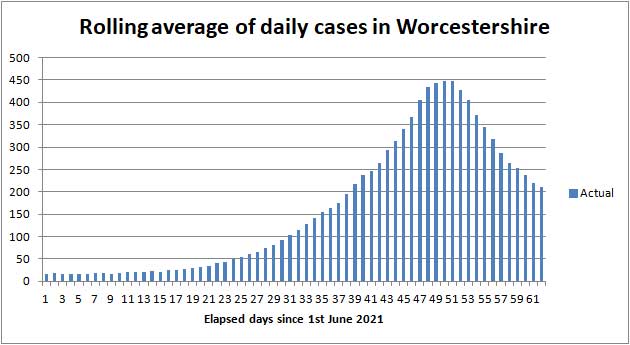
Angus and Rosemary's Miscellany
of Malvern - Other Resources
|
Coronavirus (COVID-19) epidemic weekly update for Malvern Seniors1st August 2021 DAILY CASES HIGH BUT FALLING Take care as virus still widespread
Skip to menu of archived pages PreambleWe keep an eye on the published government figures and monitor the media to asses the level of risk for Seniors in the Malvern Hills district. This page is normally updated every Sunday between 1800 and 2400 hours GMT. Information about Coronavirus can be found on the NHS website: https://www.nhs.uk/coronavirus How to get vaccinatedThe most important thing people can do now is get vaccinated. Most Seniors should have been double jabbed by now, but if not get your vaccine, and encourage others to get theirs. During July vaccinations could be obtained at the Three Counties Show Ground without an appointment. Monday to Friday 8.00am to 5.00pm Saturday 8.00am to 1.30pm (AstraZeneca and Moderna vaccinations available) Use Brown Gate entrance, postcode WR13 6NW Check Worcestershire website for availability in August.
|
| Districts of Worcs | Cases | Weekly increase | Population |
| Bromsgrove | 8,536 | +286 | 98,529 |
| Malvern Hills | 3,904 | +115 | 77,545 |
| Redditch | 7,717 | +223 | 85,317 |
| Worcester | 8,579 | +256 | 103,542 |
| Wychavon | 8,264 | +331 | 126,240 |
| Wyre Forest | 7,275 | +265 | 100,957 |
| TOTAL | 44,275 | +1,476 | 592,130 |
| COMPARE WITH | |||
| County of Hereford | 9,044 | +300 | 195,000 |
| Leicester (city of) | 44,678 | +1,223 | 400,000 |
Cumulative cases reported by PHE in Worcestershire to 1st August 2021
The weekly increase is indicative; the seven day average by area, which varies day to day, is an alternative metric that can be found on the Coronavirus dashboard.
Interactive map
At the bottom of the Coronavirus Dashboard (daily update) page there is an Interactive Map which is coloured to show the variation in infection rate across the country. This week the map shows infection rates falling across most of the UK, except Northern Ireland.
Click for Interactive Map of COVID cases
Note: the Interactive Map works on desktop PCs but it's possible you may encounter difficulties using a tablet or smartphone.
Recent weekly cases to 27th July are: North Malvern 10; Malvern Link 5; Pickersleigh 16; Barnards Green 6; Malvern Wells and Priory 12; Callow End and Hanley 5; Upton and Welland 10.
Rates are half what they were the week before.
Number of deaths
Statistics on COVID deaths are published by Public Health England, The Office of National Statistics, and NHS England.
PHE figures
Public Health England reports that the cumulative total of COVID (28) deaths in UK hospitals and care homes has risen by 561 in the last week to 129,719 while the daily average has increased from 40 to 80 deaths per day during the last fortnight.
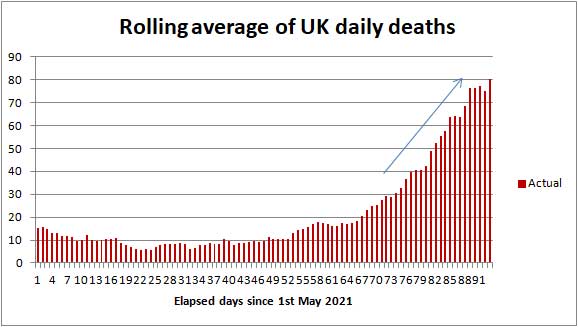
COVID-19 death rate 1st May to 1st August 2021
Click to view the UK government Coronavirus Dashboard
On average during the last fortnight the daily rate has been increasing by about two per day.
In comparison averaged over recent years 1,700 people die daily from all causes.
ONS figures
The Office of National Statistics (ONS) separately reports registered deaths in England and Wales where COVID-19 is mentioned on the death certificate. The ONS figures lag the PHE figures by 10 - 14 days and do not include Northern Ireland and Scotland.
Click for national ONS data on deaths (Excel spreadsheet)
The ONS figures are broken down by District providing a glimpse of where deaths are occurring. The provisional cumulative total of COVID related deaths in Worcestershire reported by the ONS up to 16th July 2021 (week 28 of 2021) is shown below.
Note: the numbers are from the ONS Death Registrations-Pivot table
| Districts of Worcs | Deaths 2020 |
Deaths 2021 |
Week 28 | Population |
| Bromsgrove | 164 | 102 | 1 | 98,529 |
| Malvern Hills | 61 | 83 | 0 | 77,545 |
| Redditch | 108 | 85 | 0 | 85,317 |
| Worcester | 87 | 116 | 0 | 103,542 |
| Wychavon | 157 | 119 | 0 | 126,240 |
| Wyre Forest | 171 | 106 | 0 | 100,957 |
| TOTAL | 748 | 611 | 1 | 592,130 |
Provisional cumulative COVID-19 deaths registered by ONS to 16th July 2021
In week 28 just one COVID death was reported in hospital in the district of Bromsgrove. In England and Wales 217 COVID-19 related deaths were reported in the week to 16th July; 38 more than the week before. Of these 22 were in a care home, 21 at home, 5 in a hospice,166 in hospital and 3 elsewhere.
In week 27 COVID deaths in England and Wales had been 70 higher than the week before, confirming the upward trend in deaths reported by PHE.
Note: summation of rows 9 to 339 of the ONS deaths Registrations-Pivot table.
The provisional UK COVID-19 death toll (as reported by PHE and ONS) for all weeks of the epidemic can be found on the Deaths tab of the Coronavirus Dashboard.
NHS England figures
The table below shows latest COVID deaths in Worcestershire hospitals reported by NHS England to 30th July.
| Worcestershire | Cumulative deaths | Past fortnight |
| Acute hospitals | 810 | 1 |
| Care hospitals | 63 | 0 |
| TOTAL | 873 | 0 |
Click for NHS COVID-19 Daily Deaths
The COVID death rate in Worcestershire remains very low.
Risk of COVID-19 death by age band
NHS England provides an analysis of COVID-19 deaths in hospital in England and Wales by age band. Shown below is a breakdown of recent deaths for the period 1st June 2021 to 8th July 2021 when the death rate averaged 10 deaths per day.
| Age band | Number of deaths | % of deaths |
| 0 - 19 | 5 | 1 |
| 20 - 39 | 17 | 5 |
| 40 - 59 | 66 | 18 |
| 60 - 79 | 135 | 37 |
| 80+ | 144 | 39 |
Risk of COVID-19 death by age band
Those aged 60+ years still account for 76% of deaths compared to 92% last year, but remember the death rate as a proportion of new cases is about ten times lower than in 2020.
Most fatalities are said to have been vulnerable people with an unhealthy lifestyle, and the obese.
Healthcare numbers
The UK government Coronavirus Dashboard includes important information about healthcare statistics.
| Hospital COVID cases (UK) | Number | Change in last fortnight |
| Patients currently in hospital | 5,916 | +1,952 |
| Patients on ventilation | 869 | +318 |
| Patients admitted daily | 911 | +171 |
Headline summary of patients in hospital as reported 1st August 2021
The number of patients in hospital has flat-lined this week, when we thought it might have risen to 10,000 corresponding to the peak of 47,000 new daily cases ten days ago. The number of patients admitted daily has also flat-lined at the 900 mark.
The number of patients on ventilators seems rather high, bearing in mind the media reports that, in this wave, 'few' patients were being ventilated.
There are currently no signs of extreme pressure being put on hospitals.
Worcestershire hospital beds
Tabulated figures for bed occupancy in Worcestershire Acute and Care hospitals can be found on the NHS England website.
Click for NHS England COVID-19 Hospital bed Activity
An easy to read summary can be found on the Worcestershire Coronavirus Dashboard.
Click to view Worcestershire Coronavirus Dashboard.
There are now 44 COVID-19 patients occupying Worcestershire Acute Hospital beds, of which 1 is a ventilated bed; roughly 16% of the peak experienced last January.
Note: it's possible as hospitals fill in Birmingham, where there are many more cases, part of the overflow could be sent to acute hospitals in Worcestershire.
Forecast for the week ahead
Trends suggest that during the next seven days (up to 8th August) the cumulative total of new UK COVID-19 cases reported by PHE on the Coronavirus Dashboard could increase by 190,000 towards 6,071,000.
In Worcestershire about 1,500 new cases of COVID-19 can be expected, and about 120 cases in the Malvern Hills district.
We estimate the number of COVID (28) deaths will increase by about 560 nationally towards 130,300 during the 7 days ending 8th August 2021.
In the county of Worcestershire, assuming a 0.2% death rate, the 1,476 new cases this week should translate to no more than 3 COVID deaths per week in the first half of August.
Longer term forecast
The sharp fall in daily cases during the last fortnight was not predicted by SPI-M modelling and Prof Tim Spector (of the Zoe app) wonders whether the PHE figures can be believed, while others may be wondering about the value of the computer models!
We speculate that due to vaccination and immunity arising from past infections a tipping point may have been reached where public behaviour strongly influences whether daily cases go up or down.
The elderly are likely to remain cautious so for them cases should go down; while those aged under 30, many of whom are not vaccinated, are likely to throw caution to the winds and for those cases will go up.
In consequence daily cases could stop falling next week and then possibly start climbing, but to what degree is anybody's guess.
If the fall in daily cases reported by PHE reflects reality, and is not a statistical blip, hospital admissions should start falling next week, while deaths could peak at about 80 deaths per day and then start falling the week after. Beyond that were daily cases to start rising again hospital admissions and deaths would follow in proportion.
Providing UK hospital beds occupied by COVID patients don't show signs of rising much above 10,000 the government is unlikely to reimpose restrictions.
Scientists say it is impossible to predict when the EXIT wave will peak and that will probably not be known for sure until two or three weeks after the peak is past. While it looks as though the EXIT wave may have passed it's peak, it's too early to rule out further surges in daily cases possibly leading to a bumpy tail to the epidemic.
We'll just have to wait and see how things pan out during August and adjust our behaviour accordingly.
Advice for Seniors
 Currently
there is no more than one death per week from COVID in Worcestershire so we therefore judge the
risk of death for fully vaccinated
Seniors to be
LOW while the risk of Long COVID might be MODERATE;
see our annex and riskometer opposite.
Currently
there is no more than one death per week from COVID in Worcestershire so we therefore judge the
risk of death for fully vaccinated
Seniors to be
LOW while the risk of Long COVID might be MODERATE;
see our annex and riskometer opposite.
Remember, if you are elderly, have not been vaccinated, and were to catch COVID there is a significant chance that you will either die or your long term health may be seriously damaged, so if you are able get both doses of your vaccine and continue to take care of yourself and those you love. Also encourage others to be vaccinated.
Click for our risk of death table (for those who have not been vaccinated)
Like Sajid Javid, it is quite possible, despite a second jab, for Seniors to become ill with COVID-19; some might have mild symptoms like a common cold or hay fever, while others could feel very poorly, but few except the frail and vulnerable will need to be admitted to hospital.
Until this summer's crisis is over the simple safeguards to remember are to:
-
wash your HANDS thoroughly, using soap and hot water, for 20 seconds, including after handling deliveries to your home, to kill virus picked up from contaminated surfaces see note 1;
-
wear a FACE covering when unavoidably near other people for example when shopping, visiting hospital or the chemist, and using public transport;
-
SPACE at least 2 metres from people you don't feel safe with see note 2;
-
preferably socialise with friends and other households outdoors in the FRESH AIR, else, if you can, keep doors and windows open if you are indoors;
-
minimise TIME near strangers;
-
look out for symptoms and self-isolate and book a test if you feel unwell (the top five symptoms amongst the vaccinated in order of prevalence are now said to be headache, runny nose, sneezing, sore throat and loss of smell).
-
keep away from crowded indoor settings and areas where the infection rate is known to be high.
-
Respect others and give them space.
Notes:
1) Wash your hands thoroughly before touching your face to avoid transferring virus from contaminated surfaces to your mouth, eyes and nose. If outdoors use hand gel.
2) Two metres is further than you think - roughly an arm and a walking stick away.
Annex to 1st August update
Commentary
On Monday 19th July the PM held a press briefing confirming the lifting of legal restrictions. He struck a more cautious tone than the previous week emphasising that we must continue to be cautious to avoid hospitals being overwhelmed with COVID patients in August.
Click for PM statement at coronavirus press conference: 19 July 2021
Scientists expected COVID cases to spiral after the lifting of restrictions but two days later the daily cases reported by PHE began falling.
On Friday the 23rd July the Independant SAGE briefing discussed Long COVID. Long COVID was defined as symptoms that persisted for up to 12 weeks, whereas symptoms persisting for more than 12 weeks were referred to as Post COVID Syndrome.
To date there are no predictors such as severity of illness indicating who is likely to suffer from Long COVID.
The symptoms of Long COVID were said to be:
-
Fatigue
-
Feeling breathless, whether or not lung damage was found
-
Pain in the chest
-
Muscle pains
-
'Foggy brain' leading to poor memory and difficulty making decisions
On Friday 30th July the ONS COVID infection survey reported that up to 24th July cases were increasing, while Prof Tim Spector reported cases were flat-lining in his weekly Zoe COVID Study update thus casting doubt on the figures reported by PHE.
If daily cases are truly falling we should see hospital admissions and the death rate begin to fall in the next week or two.
It may be another two weeks before direction of travel is confirmed.
The weekly Independent SAGE briefing is worth looking at if you are interested in charts and how the numbers have been changing:-
Click to watch Independent SAGE 30th July briefing
The other issue raised this week has been the high number of people pinged by the NHS COVID app and asked to self isolate.
As far as we know the 'ping' is advisory and there is no legal requirement to self isolate, the government has a scheme for fully vaccinated critical workers to test daily instead of self isolating, and after 16th August there will be no requirement for fully vaccinated individuals to self isolate unless they test COVID positive, so this issue should soon go away.
Overseas travel
The government is planning for fully vaccinated individuals from the US and most EU countries to enter the UK without having to quarantine.
Click for BBC report - No quarantine for fully jabbed US and EU travellers
It is now possible to get an NHS Vaccination Pass for overseas travel, which will require you to prove your identity for example by providing a photo of your passport; this should facilitate return to the UK from Amber list countries, except France.
Click for information about the NHS COVID Pass
See BBC report - EU vaccine 'passport' and what it means for travel
List of vaccines
Here is the list of vaccines ordered by the UK - a shortage of vaccine had been limiting the vaccination rate in the UK earlier in the year, but possibly not now. Plenty of vaccine is on order for delivery later in 2021 some of which may be needed for booster jabs and vaccinating those aged 12 - 18 years.
| COVID-19 vaccine | Doses ordered (million) | Status |
| Pfizer BioNTech, two dose, -70 deg C | 40+60 | Approved, deliveries continuing, made in Belgium (EU). An additional 60M doses have been ordered for booster shots for the most vulnerable in the autumn. |
| Astrazeneca, two dose, fridge | 100 | Approved for those aged 30+ years; deliveries continuing. Batches made in UK, Belgium and India. |
| Moderna, two dose, -20 deg C | 7+10 | Approved. First deliveries to Wales and Scotland 7th April 2021 then England 13th April; mainly for those aged under 50 years awaiting vaccination. |
| Valneva, two dose | 60+40 | A jab from French company Valneva will be made in Livingston, West Lothian, Scotland. Delivery to start in second half of 2021. |
| Janssen, single dose | 20 | Approved, a jab from Belgian firm Janssen, owned by Johnson and Johnson; UK approval 28th May. Order reduced from 30 to 20M. |
| Novavax | 60 | A jab manufactured by US firm Novavax is being made in Stockton-on-Tees UK; phase III trials complete, awaiting approval. Should be available later this year. Glaxo Smith Kline (GSK) has been contracted to fill and package vials. |
| GSK Sanofi | 60 | Some delay due to adjusting the formula to give better protection to the elderly; expect approval end 2021. |
| Curevac | 50 | Contract placed with German company Feb 2021. Possible source of new variant vaccine later in 2021 |
Table of vaccines ordered by the UK government
Present rate of new cases and risk
The average rate of infection per 100,000 population per week in England has fallen from 399 a fortnight ago to 305 while in comparison the figure for Worcestershire is now 273 and the Malvern Hills 169.
As a yardstick we suggest a figure of below 10 can be considered LOW.
There is still a fair chance of catching COVID-19 within the Malvern Hills but as most Seniors and the middle-aged have been vaccinated with 2 jabs we judge the risk of death LOW. While few will now die of COVID a greater number will suffer from Long COVID so that risk might be assessed MODERATE. A member of the family has had Long COVID and it is very debilitating.
The risk of death from Coronavirus for unvaccinated children and healthy teenagers is said to be small so for them the risk is LOW. There is however emerging concern that one in six youngsters might suffer from Long COVID.
About the final UK COVID-19 death toll
At the start of the epidemic on 17th March 2020 the Chief Scientific Adviser, Sir Patrick Valance, questioned by the Health Select Committee, did not disagree with Jeremy Hunt's suggestion that a death toll of 20,000 might be a reasonable outcome.
On the other hand, Professor Neil Ferguson of Imperial College warned in some scenarios the death toll might be as high as 250,000; while we thought, in the very worst case assuming up to 1% of the UK population died the outcome might have been nearer 400,000 taking into account some build up of herd immunity.
So how well will the UK have done? When Jeremy Hunt and Sir Patrick Valance spoke there had been few deaths and they clearly underestimated what was to come. Professor Neil Ferguson was nearer the mark. A few might consider an outcome of about 130,000 deaths a fair result compared to a greater number of people dying in a very short space of time, more being permanently disabled by Long COVID, temporary collapse of the NHS and patients dying at home or queued in ambulances outside hospitals. You have only to look at the recent situation in India to imagine what could have happened.
Members of the Labour Party and others will no doubt say the UK has done poorly compared to the best performing countries such as Australia, New Zealand and Singapore where deaths have been much lower, not to mention the enormous expense of supporting those out of work and huge damage to the economy.
With hindsight, deaths might have been much lower if the second lockdown had been continued into December and January, but that would have meant cancelling Christmas, and who knows to what extent the public would have complied.
Worldwide, this pandemic is not played out and it could be a further 1 to 2 years before the 'dust' finally settles. The PM has promised an independent inquiry in Spring 2022 to learn lessons for the future.
Summary of Links
Symptoms
Article about the effects of Coronavirus on the human body
Reporting and how to obtain a test
How to get a test
https://www.nhs.uk/coronavirus
About joining the Zoe COVID Symptom Study:
Guidance
UK government Coronavirus guidance
Tiers
Guidance on tiers: what you need to know
Government postcode checker to find tier for other areas
Statistics
UK government Coronavirus Dashboard
Coronavirus Dashboard Interactive Map
ONS data on deaths in England and Wales (Excel spreadsheet)
NHS England COVID-19 Daily Deaths
NHS England COVID-19 Hospital Admissions
NHS England vaccination statistics
Worcestershire Coronavirus Dashboard
Worcestershire COVID-19 Vaccinations Dashboard
A glimpse of the worldwide vaccination situation can be found on the Our World in Data website.
Click for chart showing % vaccinated
Modelling
A projection of the future COVID-19 death toll and daily deaths can be found on The Institute for Health Metrics and Evaluation website.
Click for IHME projection of COVID-19 deaths
Reports
ONS Coronavirus (COVID-19) Roundup
The bigger picture
Worldometer summary of coronavirus cases worldwide
European Centre for Disease Prevention and Control info
https://www.ecdc.europa.eu/en/geographical-distribution-2019-ncov-cases
World Health Organisation info
Window on the USA
Centre for Disease Control (CDC)
American Association of Retired People (AARP)
Worcestershire
Help:
http://www.worcestershire.gov.uk/here2help
Worcestershire County Council COVID-19 information:
http://www.worcestershire.gov.uk/coronavirus
Here you will find a useful link,
'Website: Number of new cases by date in Worcestershire'
which displays interesting COVID charts and statistics for Worcestershire
Miscellaneous
Spanish Flu
Dr Jeff Kildea's commentary about the 1919 outbreak of Spanish Flu in Australia
Views of Martin McKee, Professor of European Public Health
Follow Martin McKee on Twitter
SAGE membership
Scientific Advisory Group for Emergencies (SAGE)
Scottish government:
Link to Scottish Government website
Link to Postcode checker for COVID restrictions by protection level in areas of Scotland
Welsh Government:
Guidance on COVID alert levels in Wales

The interpretations and opinions expressed are our own
Last updated 3rd August 2021
 Blogs
>
Blogs
>
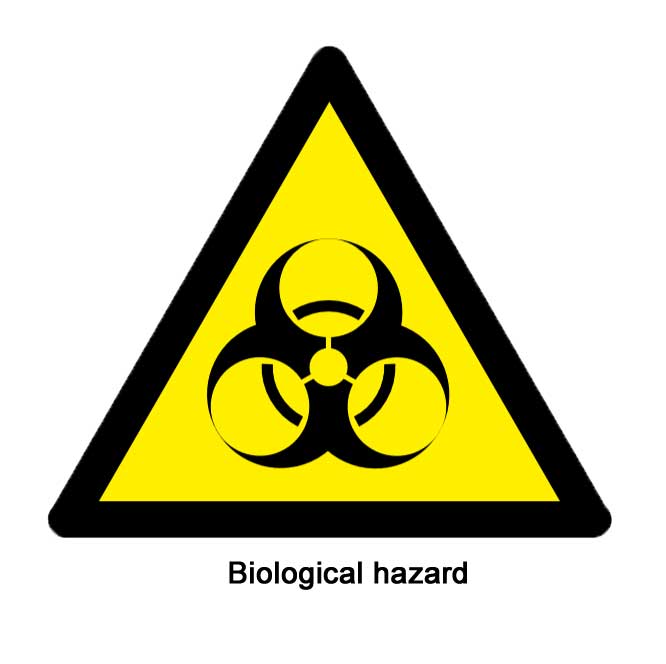 How
to request a COVID test
How
to request a COVID test You
can also collect home test kits,
packaged as the COVID-19 Self-Test (Rapid Antigen Test) in boxes of 7 tests,
from the library and most pharmacies such as Boots and Murrays in Church
Street, Claremont House and Lloyds in Barnards Green, Murrays at Prospect
View, Evans and Murrays in Malvern Link, and Boots and Morrisons on the
Enigma Retail Park. (Lateral Flow Device or as we call it the 'pregnancy
tester' shown on the right).
You
can also collect home test kits,
packaged as the COVID-19 Self-Test (Rapid Antigen Test) in boxes of 7 tests,
from the library and most pharmacies such as Boots and Murrays in Church
Street, Claremont House and Lloyds in Barnards Green, Murrays at Prospect
View, Evans and Murrays in Malvern Link, and Boots and Morrisons on the
Enigma Retail Park. (Lateral Flow Device or as we call it the 'pregnancy
tester' shown on the right).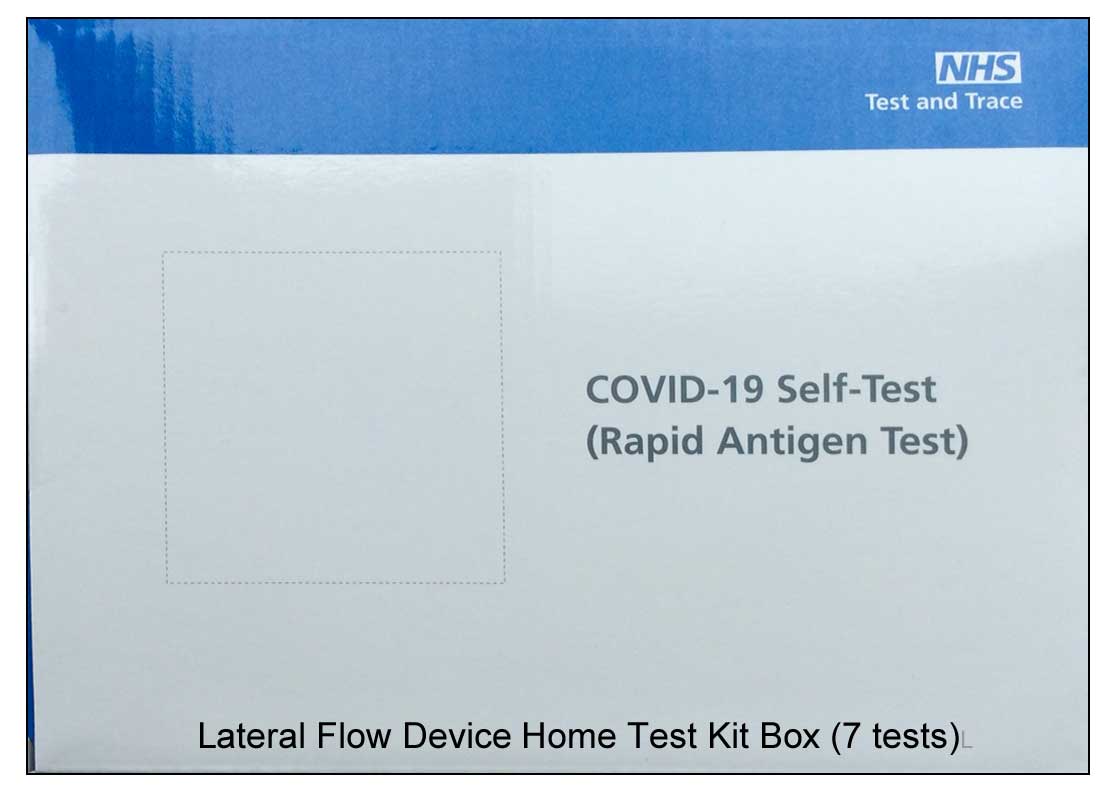
 You
can help others by downloading the COVID Symptom Study app onto your
smart phone or Ipad and reporting how you feel either daily, or as you are
able. Note there is no desktop PC version for Windows.
You
can help others by downloading the COVID Symptom Study app onto your
smart phone or Ipad and reporting how you feel either daily, or as you are
able. Note there is no desktop PC version for Windows.